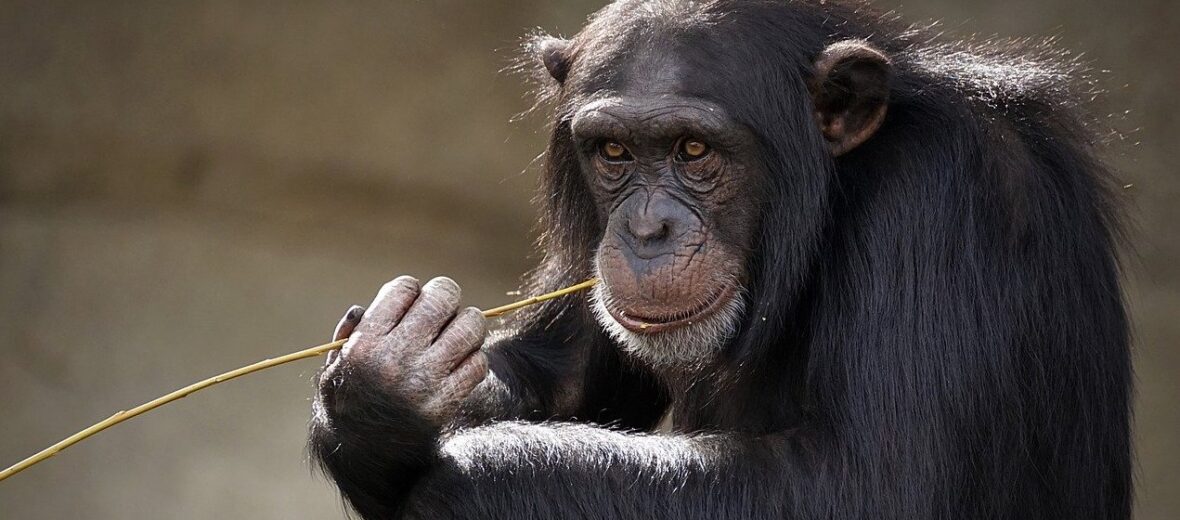
The chimpanzee can be found in the rainforests, grasslands, and woodlands of Central & Western Africa at elevations of up to 9,000 feet. Like us, chimps are highly social animals that care for their offspring for years. Chimpanzees are our closest living relatives, sharing more than 98% of our genetic blueprint! Humans and chimps are also thought to share a common ancestor who lived approximately 7+ million years ago. Chimpanzees are considered great apes and members of the Hominidae family, which includes bonobos and us humans. Chimps are listed as Endangered by the IUCN. This is due to numerous factors like: habitat loss, hunting for bush meat, disease, and climate change.
First the Stats…
Scientific name: Pan troglodytes
Weight: Up to 130 lbs.
Height: Up to 3.8 feet
Lifespan: Up to 60 years
Now on to the Facts!
1.) They use sticks to fish termites out of mounds and bunches of leaves to sop up drinking water. They also use stones to break the shells of nuts.
2.) Chimps are susceptible to the same illnesses and diseases as humans.
3.) They exchange affection such as hugs, touches, kisses, and use a complex system of sounds and gestures to communicate.
4.) Social grooming is also an important ritual performed on each other which helps to strengthen bonds and calm general nervousness.
5.) A chimpanzee is up to 7 times stronger than a human!
But wait, there’s more on the chimpanzee!
6.) Each night a chimp will rebuild their nest and change the location of said nest.
7.) Typically a chimp will walk on all 4 limbs or swing through the trees. However, they are able to walk upright on 2 legs.
Did you know…?
Chimpanzees in captivity have been successfully taught sign language.
8.) A female will give birth approximately every 3 – 4 years.
9.) A testament to their intelligence is that when they get sick, chimpanzees will typically tend to eat plants that have a medicinal value in an effort to heal themselves.
10.) Although typically gentle animals, a frightened or anxious male chimp, for example, is capable of incredible strength and a fierce ability to attack!
But wait, there’s still more on the chimpanzee!
11.) Sans humans, their only natural predator is the leopard.
Did you know…?
Like humans and even macaque monkeys, chimpanzees can recognize themselves in a mirror; indicating self awareness.
12.) A microscopic single-celled cat parasite called Toxoplasma gondii is present in leopard urine and causes cysts in the chimp’s brains and other organs. It is also thought that it causes the primates to have a fascination with their primary predator, increasing their chance of being killed and eaten. Thus completing the parasite’s life cycle.
13.) Chimps live in fission-fusion societies. Meaning that the size and formation of their social groups changes over the course of time.
14.) Due to gesture overlap, it is thought that toddlers between the ages of 1 – 2 years of age share almost 90% of gestures like hugging, stomping, jumping, and throwing things, with chimps.
15.) Sometimes troops will split into separate factions and wage war with one another over territory, food, and breeding rights.
But wait, there’s even more on the chimpanzee!
16.) These great apes follow human behaviors so closely that they even follow fashion trends, like we do. A Zambian chimp named Julie, for reasons unknown, placed a blade of grass behind her ear. In a short span of time all the others copied her sense of style.
17.) When happy, chimpanzees typically make a soft grunting sound. The facial expression that looks like a toothy grin is actually not happiness but rather fear and/or anxiety.
18.) They are also omnivores (eat both plant and animal matter). They dine on foliage, fruit, and other vegetation. They also eat insects and will even feast upon other monkeys.
Did you know…?
Washoe, a domesticated female chimp, learned American Sign Language with an amazing vocabulary of 350 words. I only know 1.
19.) Another unfortunate trait that chimps share with us humans is their ability to become inflicted with Alzheimer’s. A study looked at numerous chimp brains upon their death and found evidence of plaque and tangles of a protein associated with Alzheimer’s disease.
20.) Chimp nests are less likely to contain bacteria like dead skin, fecal matter, and more than our human beds.
But wait, there’s just a little more on the chimpanzee!
21.) Female chimpanzees come into oestrus once per month, but it lasts about 10 – 14 days and, unlike human females, they develop a large pink sexual mass on their hind ends.
22.) Male chimps can be terribly aggressive. They even plan coordinated attacks on other troops which typically leaves the alpha male critically wounded or dead.
Now a Short Chimpanzee Video!
Also, check out the Critter Science YouTube channel. Videos added frequently!
Want to suggest a critter for me to write about? Let me know here.



